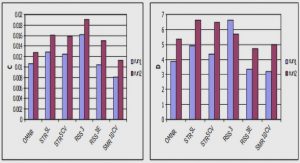Get Complete Project Material File(s) Now! »
The World Bank
The World Bank (WB) has over the years supported a wide range of pension reforms.33 Between 1984 and 2004, the Bank had already assisted 68 countries with reforms to their pension systems through more than 200 loans and credits. In addition, the Bank has issued many papers and publications on pension reform,34 which can be used as a point of reference by the countries of the world.
The World Bank promotes self-sufficiency,35 and advocates for a multi-pillar system for the provision of old-age income security.36 The first pillar comprises a mandatory publicly managed pillar that aims to be redistributive in nature;37 the second pillar is a mandatory privately managed pillar focused on saving38 (here, self-sufficiency is again encouraged and may even be forced upon citizens); and the third pillar is a voluntary pillar also aimed at savings, and personal and occupational plans that are fully funded.39 The system places greater emphasis on saving and the utilisation of both public and private arrangements, full funding, and pay-as-you-go financing.40
The Belgian pension system
Pension provision in Belgium is determined on the basis of the following three elements: profession, salary, and family circumstances.66 All Belgian pensioners receive their benefits on a pay-as-you-go basis. In terms of this approach, contributions of people who are currently employed are used to pay for the pensions of current beneficiaries. This approach is problematic and unsustainable in countries which are experiencing high levels of unemployment as the pool from which benefits should be paid depends on contributions made by those who are working and earning a salary. Such an approach will also experience challenges in situations where systems are often called upon to pay lots of death benefits resulting from deaths emanating from sicknesses and diseases such as HIV/Aids. In such cases, the number of those working and paying contributions will be reduced by the levels of deaths resulting from a pandemic.
Thus, the smaller the number of people who are paying contributions, the smaller the amount that will be available in the pool.
Belgium has private retirement schemes which are limited in size,67 and a welfare scheme providing for a minimum old-age pension.
The old-age pension is used to supplement the social insurance schemes available to employees.68 Thus the Belgian pension system comprises three pillars, namely a guaranteed minimum old-age pension; occupational pensions; and private pension schemes. These pillars are individually discussed below.
Guaranteed Minimum Old-Age Income
Social assistance is regarded as a relatively minor part of social security. However, the number of people receiving social assistance has increased over the last two decades.69 Social assistance is aimed at ensuring that people’s right to a minimum income and to access basic social services are realised, and that everyone has a dignified life.70 The Guaranteed Minimum Old-Age Income was introduced in 1946 and was extended to take its current form in 1969.71
CHAPTER 1: INTRODUCTION
1.1 BACKGROUND
1.2 THE OCCUPATIONAL RETIREMENT SYSTEM IN SOUTH AFRICA FROM A SOCIAL SECURITY PERSPECTIVE
1.3 OBJECTIVES AND OUTLINE OF THE STUDY
1.4 METHODOLOGY
1.5 SUMMARY OF PRINCIPLES AND OBJECTIVES UNDERLYING SOCIAL SECURITY AND RETIREMENT PROVISION
CHAPTER 2: INTERNATIONAL INSTRUMENTS ON THE RIGHT TO SOCIAL AND RETIREMENT SECURITY
2.1 INTRODUCTION
2.2 THE ORGANISATION OF AFRICAN UNITY AND THE AFRICAN UNION ON THE RIGHT TO SOCIAL AND RETIREMENT INCOME SECURITY
2.3 SOUTHERN AFRICAN DEVELOPMENT COMMUNITY (SADC) ON THE RIGHT TO SOCIAL AND RETIREMENT SECURITY
2.4 UNITED NATIONS (UN) ON SOCIAL AND RETIREMENT SECURITY
2.5 THE INTERNATIONAL LABOUR ORGANISATION (ILO) ON THE RIGHT TO SOCIAL AND RETIREMENT SECURITY
2.6 SUMMARY AND EVALUATION
CHAPTER 3: SOCIAL SECURITY AND PENSION SYSTEMS IN BELGIUM, THE NETHERLANDS, AND THE UNITED KINGDOM
3.1 INTRODUCTION
3.2 BACKGROUND TO THE DEVELOPMENT OF SOCIAL AND RETIREMENT SECURITY SYSTEMS IN BELGIUM, THE NETHERLANDS, AND THE UNITED KINGDOM
3.3 SOCIAL SECURITY AND PENSION PROVISION IN BELGIUM
3.4 SOCIAL SECURITY AND PENSION PROVISION IN THE NETHERLANDS.
3.5 SOCIAL SECURITY AND PENSION PROVISION IN THE UNITED KINGDOM
3.6 SUMMARY AND EVALUATION
CHAPTER 4: HISTORICAL DEVELOPMENT OF SOUTH AFRICA’S RETIREMENT SECURITY SYSTEM (STATE AND OCCUPATIONAL PENSIONS)
4.1 INTRODUCTION
4.2 DEVELOPMENTAL PERIODS FOR SOUTH AFRICA’S SOCIAL SECURITY SYSTEM
4.3 THE NATURE OF RETIREMENT SECURITY IN SOUTH AFRICA
4.4 SUMMARY AND EVALUATION
CHAPTER 5: SOUTH AFRICA’S SOCIAL AND RETIREMENT SECURITY FRAMEWORK
5.1 INTRODUCTION
5.2 A CONSTITUTIONAL FRAMEWORK
5.3 SOUTH AFRICA’S RETIREMENT SECURITY FRAMEWORK.
5.4 NON-CONTRIBUTORY STATE PENSIONS
5.5 CONTRIBUTORY OCCUPATIONAL RETIREMENT SCHEMES
5.6 VOLUNTARY PROVISIONS
5.7 INFORMAL ARRANGEMENTS
5.8 SUMMARY AND EVALUATION
CHAPTER 6: SOUTH AFRICA’S OCCUPATIONAL RETIREMENT SYSTEM
CHAPTER 7: THE FUTURE OF SOUTH AFRICA’S OCCUPATIONAL RETIREMENT SECURITY SYSTEM: SUMMARY AND RECOMMENDATIONS
GET THE COMPLETE PROJECT
SOUTH AFRICA’S OCCUPATIONAL RETIREMENT SYSTEM: A COMPARATIVE SOCIAL SECURITY PERSPECTIVE





